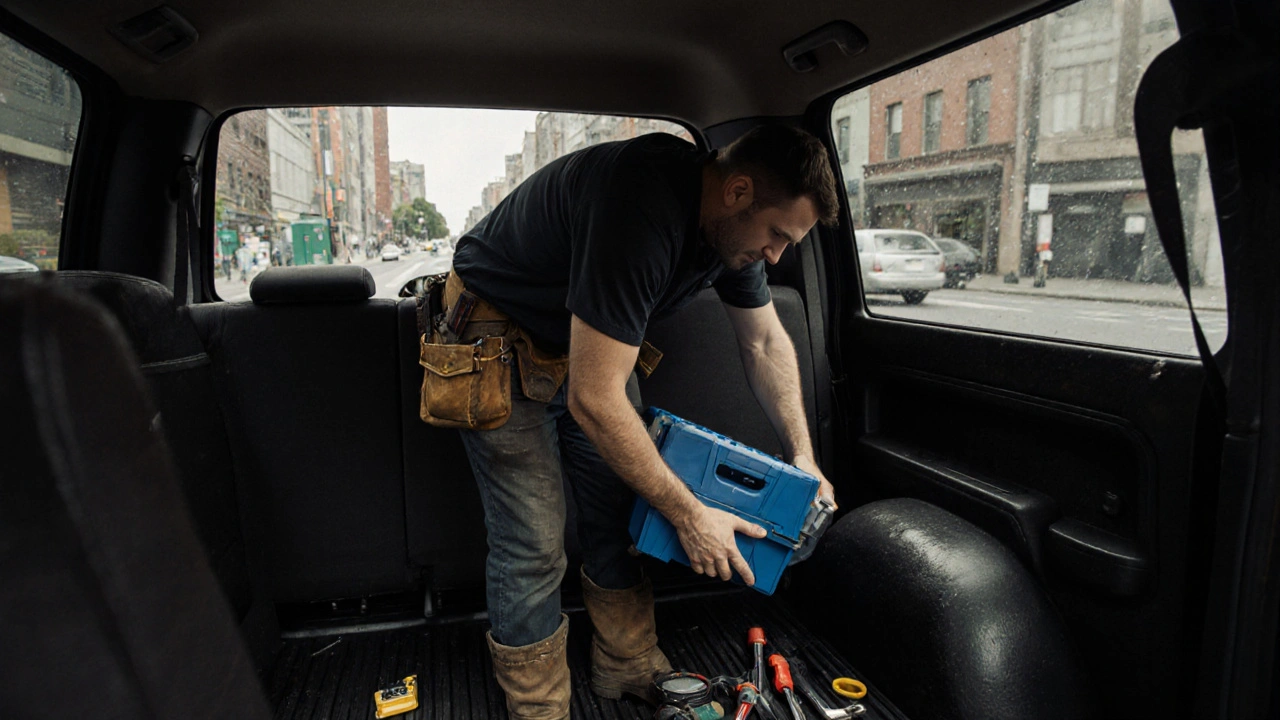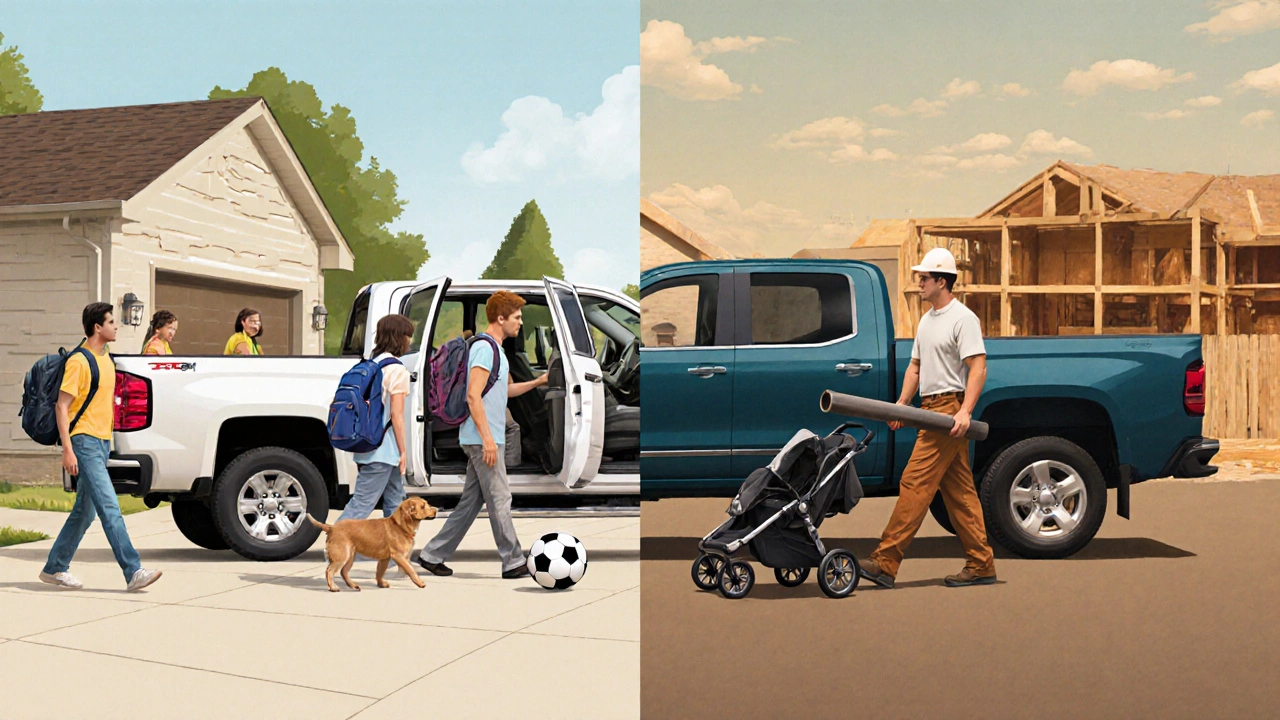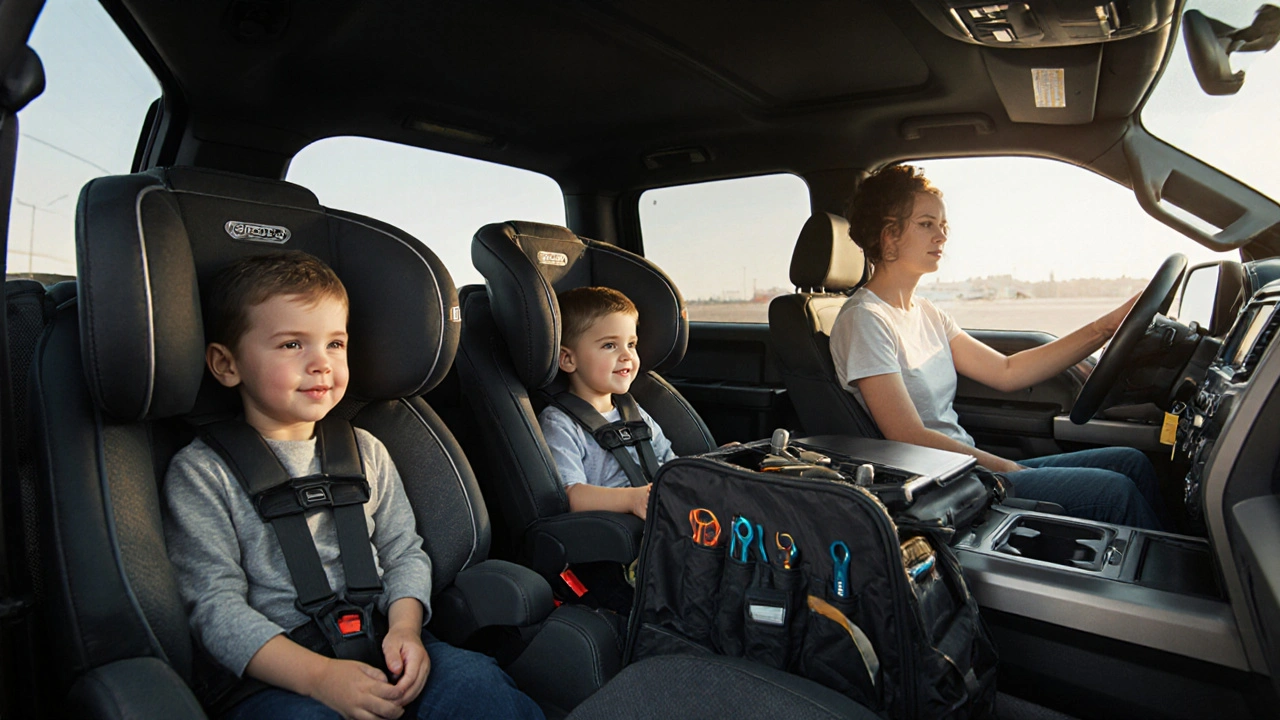When you’re standing in a dealership looking at pickup trucks, the difference between a crew cab and an extended cab isn’t just about space-it’s about your life. Are you hauling kids to soccer practice on weekends and tools to job sites on weekdays? Or are you mostly using the truck for work, with the occasional family trip? The cab type you pick changes everything: how many people fit, how much gear you can carry, how much you pay, and even how easy it is to park in a tight city lot.
What’s the real difference between crew cab and extended cab?
A crew cab has four full-size doors and seats up to five or six adults comfortably. The back seats are actual seats-not fold-up jump seats you have to climb over. You can buckle in three kids in the back, and they won’t be squished against the door. The legroom? About 35 inches on average. That’s enough for a 6-foot adult to sit without their knees brushing the front seat.
An extended cab, sometimes called a double cab or access cab, has two full front doors and two smaller rear doors. The back area is tight. It’s designed for occasional use-maybe for a kid or a toolbox. Legroom? Around 25 inches. Most adults over 5’8” will feel cramped. The seats often fold up, and the floor is raised, making it harder to get in and out.
Here’s the thing: manufacturers don’t always call these the same thing. Ford calls its larger rear-seat model a “Crew Cab.” Ram calls it “Crew Cab” too. Toyota calls theirs “Double Cab.” But if it has four full-size doors and usable back seats, it’s a crew cab. If it’s got tiny rear doors and barely enough room for a backpack, it’s an extended cab.
Family use: Who fits, and who gets left behind?
If you’ve got two or more kids under 12, a crew cab is non-negotiable. You can fit three car seats across the back without fighting for space. You can stash snacks, jackets, and soccer balls in the back without having to fold the seats. On road trips, the kids won’t be whining after 20 minutes because their legs are numb.
Extended cabs? They work if you only have one kid and you’re okay with them sitting in the front with you. But once you add a second child-or a dog-or a stroller-it gets messy. You’ll end up leaving stuff behind because there’s no room. And if your partner needs to ride shotgun while you drive, the back seat becomes a storage bin.
Real-life example: A dad in Bristol with two kids under 6 switched from an extended cab Ford Ranger to a crew cab Toyota Tacoma. He used to leave the booster seat in the car because he couldn’t fit it in the back. Now he can fit both car seats, a diaper bag, and a stroller folded behind the seats. He didn’t realize how much stress he was carrying until it was gone.
Work use: Space, access, and practicality
If you’re a tradesperson-plumber, electrician, landscaper-you care about cargo space and tool access. A crew cab gives you more interior room for gear, but it also means less bed space. Most crew cabs are 6 feet long in the bed. Extended cabs often come with 7 or 8-foot beds. That’s a big deal if you’re hauling lumber, pipes, or a full-size pallet.
But here’s the tradeoff: if you’re working alone, you might not need the extra back seat. But if you ever need to bring a helper-maybe a junior technician or a new hire-you’re stuck. Crew cabs let you bring a second person without renting a second vehicle. That saves time and money.
One electrician in Somerset told me he used to drive an extended cab F-150. He’d have to leave his tools in the bed because the back seat was too tight for his toolbox. When he switched to a crew cab, he could keep his drill, tape measure, and spare wire inside the cab. No more rain damage. No more theft risk. He cut his job prep time by 20%.

Price and value: How much extra are you paying?
A crew cab typically costs $2,000 to $5,000 more than the same model in extended cab form. That’s not just the cab-it’s the heavier frame, more materials, and added features. But here’s what most people don’t think about: resale value.
Crew cabs hold their value better. In the UK and US markets, crew cabs sell faster and for higher prices. A 2023 Toyota Tacoma Crew Cab with 40,000 miles might fetch £28,000. The same model in extended cab? Around £24,500. That’s a £3,500 gap-almost enough to cover the original price difference.
Insurance and fuel? Crew cabs are heavier, so you’ll pay a bit more. On average, you’ll see 1-2 mpg less. That adds up to about £150 extra a year if you drive 12,000 miles. Not huge, but worth noting.
Driving and parking: Is the extra size a hassle?
Crew cabs are longer. A full-size crew cab pickup can be over 20 feet long. That makes parking in tight spots harder. In Bristol’s narrow streets, or at a crowded supermarket, you’ll need more space to turn and park. Extended cabs are 1-2 feet shorter, which helps.
But here’s the twist: modern trucks have cameras, sensors, and even automated parking now. If you’ve got a crew cab with a rear camera and parking assist, the extra length becomes less of a problem. The convenience of having your whole family in the cab often outweighs the parking hassle.
One mum in Bath told me she used to dread parking her extended cab Ram. She’d have to leave the kids in the car while she hunted for a spot. With her new crew cab, she can pull into a regular space, open all the doors, and get everyone out at once. No more running back and forth. She says it’s the quietest win she’s ever had.

What do real buyers choose-and why?
According to 2024 sales data from the Society of Motor Manufacturers and Traders (SMMT), crew cabs make up over 70% of new pickup sales in the UK. That’s not because people are buying them for work alone. It’s because families want them.
Even in trade-heavy markets like Scotland and Northern England, crew cabs dominate. Why? Because most workers don’t work alone anymore. They bring assistants. They carpool. They need to move gear and people at the same time.
The extended cab isn’t dead. It still has a place. If you’re a single tradesperson who hauls long materials daily, and you rarely carry passengers, it’s a smart, cheaper choice. But if you’re a parent, a small business owner, or someone who values flexibility, the crew cab is the default.
Final decision: How to pick the right one
Ask yourself these three questions:
- Do you regularly carry more than two adults in the truck?
- Do you ever need to transport kids, pets, or gear in the back seat?
- Will you still be using this truck in five years-and will your needs change?
If you answered yes to any of those, go crew cab. Even if you think you won’t need the space now, you probably will. Life changes. Kids grow. Jobs evolve. A crew cab gives you room to grow with it.
If you’re 100% sure you’ll only ever drive alone or with one passenger, and your work demands a long bed, then an extended cab saves you money and gives you more cargo space. Just be honest with yourself. Don’t choose it because it’s cheaper. Choose it because it truly fits your life.
Test drive both. Bring your family. Bring your tools. Sit in the back. Try to buckle a car seat. See how easy it is to get in and out. The difference isn’t subtle. You’ll know right away which one feels like home.
Is an extended cab big enough for a family?
An extended cab can work for a small family-like one child and two adults-but it’s tight. Back seats are small, often with limited legroom and no room for car seats side-by-side. If you have two or more kids, or need to carry gear like strollers or sports equipment, you’ll quickly run out of space. Crew cabs are far more practical for families.
Do crew cabs cost more to insure and fuel?
Yes, slightly. Crew cabs are heavier, which means they use about 1-2 miles per gallon less than extended cabs. Insurance premiums are also a bit higher due to the increased value and repair costs. But the difference is small-around £150 a year in fuel and £50-£100 in insurance. The added comfort and resale value usually make up for it.
Can you fit three car seats in a crew cab?
Yes, most crew cabs have enough width in the back seat to fit three car seats across, though it can be snug. Models like the Toyota Tacoma, Ford Ranger, and Volkswagen Amarok have wider rear seats that make this easier. Always test fit your specific seats before buying. Some bulky infant seats might require you to skip one or use the front passenger seat.
Which truck has the best crew cab for work and family?
The Toyota Tacoma Crew Cab and Ford Ranger Crew Cab are top choices in the UK. Both offer good rear legroom, reliable engines, and strong resale value. The Tacoma has a slightly more comfortable back seat for adults, while the Ranger offers more payload capacity and a slightly longer bed. For heavy work and family use, either is a solid pick.
Are extended cabs becoming obsolete?
Not quite, but they’re rare. Most manufacturers now focus on crew cabs because that’s what buyers want. Extended cabs are mostly available on base models or in markets where bed length is critical-like rural farming areas. In cities and for families, they’re largely being phased out. If you find one, it’s usually because it’s cheaper or you need the extra bed space.


Comments
James Boggs
Crew cab all the way. My kids are 4 and 6. We used to leave the booster seat in the car because it wouldn’t fit. Now? Both seats, stroller, and snacks. Life changed.
November 4, 2025 at 09:14
Addison Smart
Let’s be real-extended cabs aren’t obsolete, they’re just misunderstood. I’m a carpenter in rural Montana. I haul 16-foot lumber daily. My extended cab F-150 has an 8-foot bed. I don’t need five seats. I need space. And yes, my 8-year-old sits in the front with me. She’s fine. She’s not a passenger, she’s my co-pilot. The market’s shifting because families want convenience, not because extended cabs are flawed. They’re just for different lives. And that’s okay.
November 4, 2025 at 17:37
David Smith
Oh wow, another one of those ‘just get the crew cab’ sermons. Like your kids are going to die if they don’t have 35 inches of legroom. I’ve seen toddlers cry in a Tesla because the cup holder was too far. You people turn every decision into a trauma. Extended cabs are fine. You just don’t want to be responsible for your own choices. Grow up.
November 4, 2025 at 21:54
Lissa Veldhuis
Y’all are acting like the crew cab is the holy grail of parenting but let me tell you something I saw at Target yesterday-some dude trying to parallel park a crew cab Tacoma with three car seats in the back and a dog in the front seat and a stroller in the middle and his wife yelling at him from the sidewalk like he was a human wrecking ball and I just stood there thinking this is what capitalism did to us we turned trucks into parenting battlegrounds and nobody even noticed
November 6, 2025 at 13:19
Michael Jones
It’s not about the truck it’s about the life you’re building. You think you’re choosing between two cabs but you’re really choosing between comfort and convenience versus scarcity and sacrifice. The crew cab isn’t a luxury it’s a declaration that your family matters enough to have space to breathe. And that’s not just practical it’s spiritual. You don’t need a PhD to get that you just need to stop thinking like a consumer and start living like a human
November 7, 2025 at 16:31
allison berroteran
I really appreciated how the post broke down not just the specs but the emotional weight behind each choice. I bought an extended cab because I thought I’d only ever drive alone, but then my niece started visiting every weekend and suddenly the back seat became a snack zone, a book pile, and a nap spot. I didn’t realize how much joy that small space could hold. It’s not about max capacity-it’s about how much love you can fit in. And sometimes, that’s more than you think.
November 8, 2025 at 03:21
Gabby Love
Just a quick note: the 1-2 mpg difference for crew cabs is accurate, but it’s worth noting that newer models (2022+) with turbocharged engines and mild hybrids have narrowed the gap significantly. Also, some extended cabs have folding rear seats that still allow for decent cargo space-check the specs before assuming. And yes, three car seats fit in most crew cabs, but always test with your actual seats. Some are wider than others.
November 10, 2025 at 00:46
Jen Kay
How charming. The crew cab is now a moral victory. I suppose if you don’t buy one, you’re also neglecting your children’s emotional development and failing to uphold the sacred American tradition of over-sized vehicles. Let me guess-you also buy organic kale and name your dogs after philosophers. Just saying: sometimes a simple life is better than a perfectly appointed one.
November 11, 2025 at 12:44
Michael Thomas
Extended cabs are for real Americans. Crew cabs are for suburban moms who think their kids need a limo to soccer. We don’t need four doors and legroom. We need a truck that works. America built itself on trucks that didn’t coddle. Get back to basics.
November 11, 2025 at 20:00
Abert Canada
As a Canadian who drives a crew cab in winter, let me say-this isn’t about luxury. It’s about survival. My wife and I haul our two toddlers and a dog to ski trips. In -30°C, you don’t want to be climbing into a cramped back seat. You want to open all four doors, get everyone in warm, and go. Crew cab saved our winters. Also, parking? We use the automatic system. It’s fine. Stop worrying about parking.
November 13, 2025 at 18:28
Ian Maggs
It’s fascinating, isn’t it? The crew cab represents a societal pivot-from utility to comfort, from individualism to collective accommodation. The extended cab, in its diminished form, is a relic of the industrial ethos: work first, people later. But now, we live in a world where the family unit is the engine-not the cargo. The truck is no longer a tool; it’s an extension of the home. And that shift? It’s profound. The numbers don’t lie. 70% isn’t a trend-it’s a transformation.
November 15, 2025 at 16:51
Flannery Smail
Everyone’s acting like crew cabs are the only option. What about the guy who needs to haul a 12-foot kayak and doesn’t have kids? Or the single guy who drives 200 miles a week for work? You don’t need a minivan with a pickup bed. Extended cabs are still the smart choice for a lot of us. Stop pretending everyone lives your life.
November 17, 2025 at 16:49
Emmanuel Sadi
Oh wow. So now we’re supposed to feel guilty for not buying a $50k truck because we might one day have a second kid? This is why America is broke. You people turn every purchase into a moral obligation. I drive a 2010 extended cab. I fix my own stuff. I don’t need a back seat. I need a job. Maybe if you spent less time worrying about car seats and more time fixing your income, you wouldn’t need a crew cab to feel like a good parent.
November 18, 2025 at 20:01
Nicholas Carpenter
My brother bought an extended cab because he thought he’d never need more space. Then his wife got pregnant. Then their dog got sick and needed frequent vet trips. Then his parents started helping with childcare. Now he’s trading up. Don’t wait for life to change you. Get the crew cab before you need it. You’ll thank yourself later.
November 20, 2025 at 19:24
Chuck Doland
While the article presents a compelling case for crew cabs, it is essential to acknowledge that the terminology used by manufacturers is inconsistent and often misleading. For instance, Toyota’s ‘Double Cab’ is functionally equivalent to Ford’s ‘Crew Cab,’ yet the nomenclature implies a hierarchy that does not exist. Furthermore, the assertion that extended cabs are being ‘phased out’ is overstated; they remain available across nearly all major platforms, albeit typically as base trims. The true metric of suitability lies not in marketing labels, but in the physical dimensions of the rear passenger compartment and the user’s specific, verifiable needs. One must not conflate popularity with necessity.
November 22, 2025 at 17:54